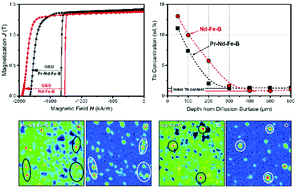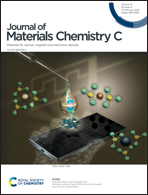Rationally selecting the chemical composition of the Nd–Fe–B magnet for high-efficiency grain boundary diffusion of heavy rare earths
Abstract
Grain boundary diffusion (GBD) efficiency of heavy rare-earth (HRE) elements for Nd–Fe–B magnets is closely related to the chemical composition of the initial magnets but this has not been well studied yet. Here, we demonstrated the significant difference in the diffusion efficiency of Tb for Pr–Nd–Fe–B and Nd–Fe–B magnets. After the GBD treatment with Tb70Cu30 alloy, the coercivity of the Pr–Nd–Fe–B magnet increases from 1324 to 1837 kA m−1, while that of the Nd–Fe–B magnet increases from 1269 to 1952 kA m−1. The Nd–Fe–B magnet achieves a significantly higher coercivity enhancement of 54% than Pr–Nd–Fe–B (39%) mainly due to the deeper infiltration depth of Tb in the Nd–Fe–B magnet. Since Pr is more active than Nd, more oxygen is introduced into the Pr–Nd–Fe–B magnet during powder metallurgy. A great amount of rare-earth oxides existing at the grain boundaries block the channels for Tb diffusion and result in the accumulation of Tb at the diffusion surface, which prevents the deep diffusion of Tb in the Pr–Nd–Fe–B magnet. In addition, both experiment and thermodynamic calculations demonstrate that HREs of Tb and Dy prefer to react with the existing (Pr,Nd)2O3 at the triple-junction regions, which causes unnecessary consumption of HRE at triple-junction phase. Hence, to achieve high GBD efficiency, the Pr-free Nd–Fe–B initial magnets with low content of O are preferable. The present results indicate that the rational selection of initial magnets is important for performance improvement by GBD treatment and also for the efficient use of rare-earth resources.



 Please wait while we load your content...
Please wait while we load your content...